This study was produced through a collaboration between Him For Her and Crunchbase. Contributors include Laura Gluhanich, Emma Cotter and Sarah Mosley of Him For Her, Albrey Brown of Airtable, and Gené Teare from Crunchbase. Base10 and Emergence Capital contributed supplementary data to this research. Lauren Rivera, professor at Kellogg School of Management, co-authored the original benchmark study on which this update is based.
The study
When it comes to board diversity, public companies attract the most scrutiny. How do high-growth private companies—those often credited with driving technical innovation and disrupting established industries—fare in terms of diversity in the boardroom?
That’s what Him For Her set out to understand three years ago. In 2019, through a collaboration with Crunchbase and Kellogg School of Management Professor Lauren Rivera, we published the first of our annual tracking studies measuring diversity on the boards of the most heavily funded private companies. This report summarizes our findings for 2021, providing a third set of data points as we track progress and trends in private-company board composition.
Search less. Close more.
Grow your revenue with all-in-one prospecting solutions powered by the leader in private-company data.
Included in this study are 500 companies, which represent nearly $140 billion in funding and more than 180,000 employees, and their combined 3,437 board members (3,042 unique people).
Key findings
- Women hold 14 percent of board seats among the companies studied, up from 11 percent in 2020 and 7 percent in 2019.
- Nearly 40 percent of companies don’t have any women on their board, an improvement from roughly half of the companies in our 2020 study and 60 percent in 2019.
- Only 3 percent of all directors are women of color, reflecting no significant change from the prior year.
- More than three quarters of company boards (78 percent) do not include a single woman of color.
- Women are most likely to occupy an independent director seat (56 percent), as compared with an investor director (31 percent) or executive director (13 percent) seat.
- Investor directors now hold less than half of board seats (48 percent, down from 56 percent in 2019), as independent directors command a larger board footprint (29 percent, up from 20 percent in 2019).
- Life sciences companies outperform technology companies on board-diversity metrics.
While our analysis points to continued progress in boardroom diversity among the private companies studied, the rate of change has slowed when it comes to gender diversity, and we observed no improvement for women of color.
In recognition of the mounting evidence connecting corporate performance with board diversity, investors such as State Street and Goldman Sachs, along with state legislatures in California and Washington are calling on businesses to include more women and people of other underrepresented groups in corporate governance. For companies and their stakeholders to realize the myriad benefits associated with board diversity— including increased innovation, greater financial returns and improved ESG performance—CEOs and board directors must make a commitment to sourcing diverse candidates unconstrained by the limited reach of their personal networks.
Women hold 1 in 7 board seats—fewer than one per company
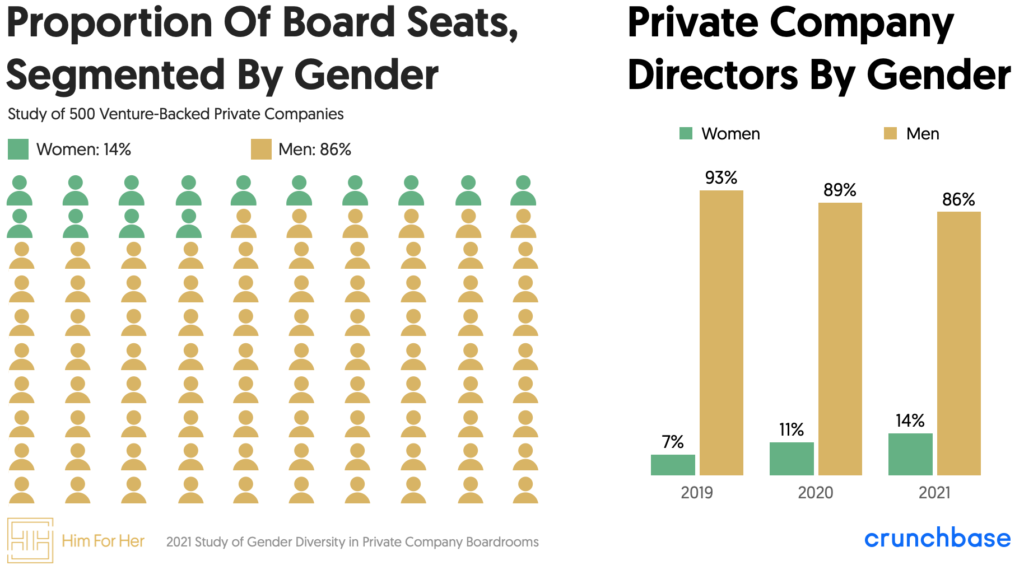
The percentage of woman board members grew from 11 to 14 in 2021, though women gained fewer seats than in the year prior. Among public companies, women hold 30 percent of the director seats on the boards of S&P 500 companies and 26 percent on the boards of Russell 3000 companies.
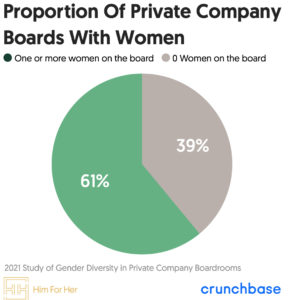 For the first time, more than half (61 percent) of the companies studied have at least one woman on their board, leaving nearly 2 in 5 without any gender diversity. Among the Russell 3000, only 3 percent of boards are all-male.
For the first time, more than half (61 percent) of the companies studied have at least one woman on their board, leaving nearly 2 in 5 without any gender diversity. Among the Russell 3000, only 3 percent of boards are all-male.
Within our study, the companies being governed by all-male boards represent more than $50 billion in funding and employ roughly 90,000 people.
The average number of women per board remains less than one. More than half (58 percent) of women directors are the only woman in the boardroom. While research suggests that boards need at least three women to capture the full economic benefits of diversity, only 25 percent have more than one and just 9 percent have more than two.
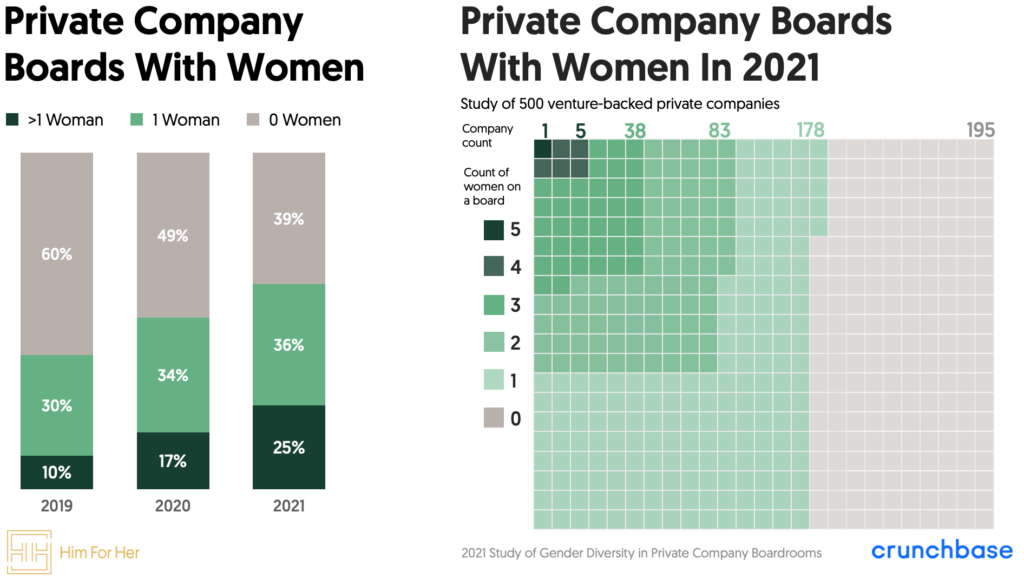
Among board members studied, as many are named David as are women of color
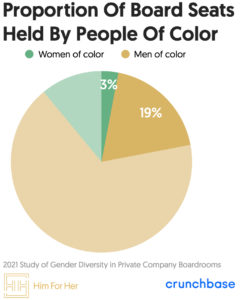 Of the 3,437 board seats included in the study, approximately 19 percent are held by men of color and only 3 percent by women of color. By comparison, within the S&P 500, 10 percent of directors are women of color. More than two-thirds (69 percent) of companies studied have at least one man of color on the board, while fewer than a quarter (22 percent) include a woman of color on their boards. The number of men of color (594) among the board directors studied exceeds the total number of women of all races and ethnicities (436).
Of the 3,437 board seats included in the study, approximately 19 percent are held by men of color and only 3 percent by women of color. By comparison, within the S&P 500, 10 percent of directors are women of color. More than two-thirds (69 percent) of companies studied have at least one man of color on the board, while fewer than a quarter (22 percent) include a woman of color on their boards. The number of men of color (594) among the board directors studied exceeds the total number of women of all races and ethnicities (436).
Notably, among the board members included in our study, roughly as many are named “Dave” or “David” (107) as are women of color (110).
Investor directors now hold fewer than half of board seats
While the average board size remained essentially unchanged at 6.9 members, compared with 6.8 in each of the prior years’ studies, the mix of directors by role shifted.
Directors on private-company boards can be classified in three groups: executive directors, investor directors and independent directors. CEOs, co-founders and any members of the company’s management team who hold board seats are considered executive directors. These make up 23 percent of the board seats within the companies studied, consistent with our findings last year.
As venture-backed companies raise outside funding, investors often take seats on the board. Within the study data, investor directors make up the largest pool of board members for venture-backed companies, with 48 percent of seats, down from 53 percent in 2020 and 56 percent in 2019.
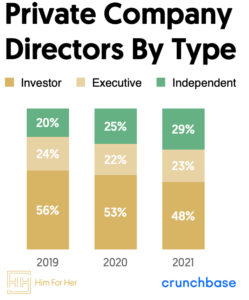 Independent directors are typically the last category to be added to the board, as they are neither tied to the company’s founding management team nor early investors. Private companies are not required to have independent directors; however, public companies must have at least one independent director, depending on the size of the board. Independent directors comprise 29 percent of the seats among the private companies studied, up from 25 percent in 2020 and 20 percent the year prior. The number of boards with at least one independent director grew from 71 percent in 2019 to 83 percent in 2021.
Independent directors are typically the last category to be added to the board, as they are neither tied to the company’s founding management team nor early investors. Private companies are not required to have independent directors; however, public companies must have at least one independent director, depending on the size of the board. Independent directors comprise 29 percent of the seats among the private companies studied, up from 25 percent in 2020 and 20 percent the year prior. The number of boards with at least one independent director grew from 71 percent in 2019 to 83 percent in 2021.
Gain in independent seats furthered gender diversity
Most woman board directors hold independent seats (56 percent). While the number of women in executive director and investor director seats has grown modestly over the last two years, women saw the greatest gains within independent seats, from 19 percent women in 2019 to 27 percent women in 2021.
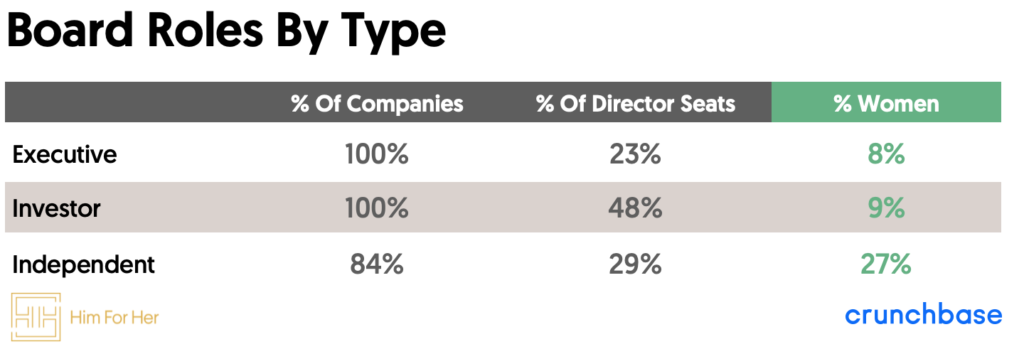
Combined, executive and investor directors hold 71 percent of board seats, of which only 9 percent are occupied by women. This gender imbalance reflects the underrepresentation of women among both startup funders and founders, with the downstream effect apparent in the boardroom.
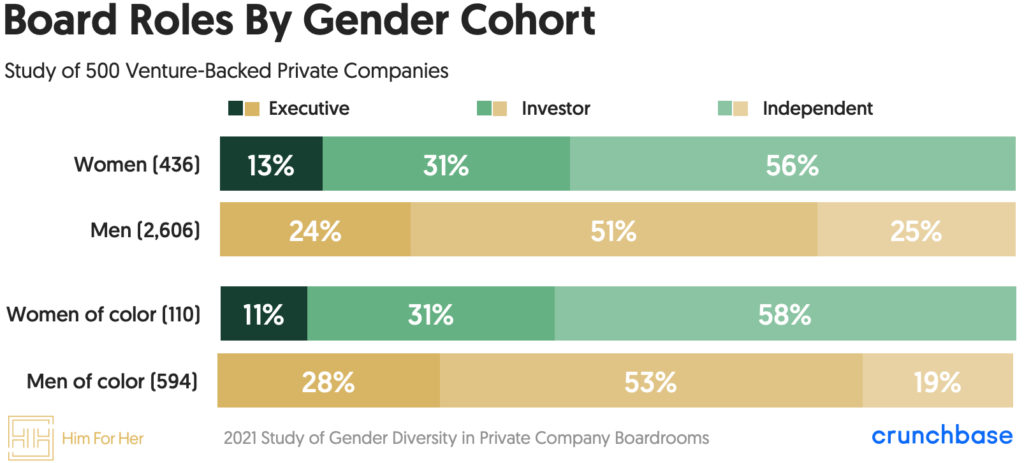
With the addition of an independent director, companies have the freedom to select candidates who bring both key expertise and new perspectives. The increase in the percentage of independent board seats was a contributing factor to boardroom gains for women over the last year.
Life-sciences companies have slightly more diverse boards
Among the companies studied, nearly equal numbers operate within life sciences (225) and technology (228), with the remaining 47 companies predominantly in energy-related fields. The boards of life-sciences companies fare better on diversity metrics than the boards of technology companies.
Within the life-science companies, 17 percent of board directors are women and 70 percent of boards include at least one woman. By comparison, among technology companies, only 11 percent of directors are women and 54 percent of boards include a woman.
Summary
We are encouraged to see continued progress in diversity within the boardrooms of the most heavily funded private companies. Yet celebrating the fact that women hold 1 in 7 directorships when they account for roughly a quarter of corporate C-suite roles—nearly half of the U.S. workforce—and half of all consumers, ignores the gaping hole in corporate governance.
Even more concerning, the pace of improvement is slowing. Our annual tracking study revealed greater gains for women between 2019 and 2020 than over the past year. Additionally, as more companies add their first woman director, a “one and done” mentality may counteract the broader tailwinds driving change.
Meanwhile, our study indicated no improvement in the sliver of board seats held by women of color.
Building diverse boards requires a novel approach to board recruitment. Boards look the way they do today because new directors are typically tapped from the personal networks of those already in the boardroom. Because our personal networks tend to look like we do, this practice creates a self-reinforcing cycle that inadvertently excludes women and people of color. As a result, business leaders literally cannot see the wealth of talent that lies beyond the peripheral vision of their existing relationships.
CEOs and their boards can build more diverse boards by:
- Prioritizing the addition of an independent director earlier in the company’s lifecycle.
- Focusing on expertise rather than title; requiring that a candidate have CEO experience automatically favors men, whereas defining specific criteria, such as size of P&L or scaling experience, yields a broader pool of qualified candidates.
- Building a diverse pipeline of candidates by identifying sources outside the personal networks of those in the boardroom today.
The good news: It’s a network problem, not a pipeline problem. Business leaders committed to building diverse boards will not lack for impressive candidates if they look in the right places.
Him For Her, a social impact venture, was created to make it easy for companies to identify outstanding candidates who bring expertise and perspectives critical to companies’ success. We look forward to a time when board diversity becomes so commonplace that tracking is no longer necessary.
Methodology
This tracking update largely reproduced the methodology employed with our prior studies published in December 2019 and March 2020. For this update, we analyzed 500 of the most heavily funded private U.S.-based companies to understand the composition of their boards as of Q4 2021, one year after the prior study and two years after the original.
Leveraging the Crunchbase database, we identified 1,950 U.S.-based private companies founded since 2003 with cumulative funding of at least $100 million as of June 30, 2021. To ensure that each company’s board profile was current, we included only companies that publish their board of directors on their website.

We then referenced company website data, Crunchbase profiles and other publicly available information to characterize the board members. The study included only board directors; board observers and/or advisers were excluded from the data set. For each company, we segmented board members according to type: executive, investor or independent. In the few cases in which founders and past executives remained on the board despite no longer having an operating role at the company, we classified them as “executive directors” in recognition of their original relationship to the company. We identified gender by referencing the professional profiles on Crunchbase. For racial/ethnic identity, we leveraged self-identification information where available, and supplemented with contextual information and visual identification. As reflected by U.S. Census data collection, people of color include Black or African American, American Indian or Alaska Native, Asian, Native Hawaiian or Other Pacific Islander, Hispanic or Latino.
About the Authors
Him For Her is a social impact venture aimed at accelerating diversity on corporate boards. To bridge the network gap responsible for the sparsity of women in the boardroom, Him For Her engages business luminaries to connect the world’s most talented “Hers” to board service. Since its founding in 2018, Him For Her has built a referral-only talent network of 4500+ board-ready women, more than a third of whom are women of color, and provided free board referrals to 800+ companies ranging from start-ups to S&P 100. Him For Her creates warm introductions between board candidates and CEOs through more than 100 roundtable discussions guest-hosted by renowned leaders such as Scott Cook, Carmine Di Sibio, Robin Washington, Eric Yuan and many more. A 501c3 corporation, Him For Her provides its services free of charge thanks to supporters like Brad Feld & Amy Batchelor, Reid Hoffman, Jeff Weiner, Nasdaq and others.
Crunchbase is the leading provider of private-company prospecting and research solutions. Over 70 million users — including salespeople, entrepreneurs, investors and market researchers — use Crunchbase to prospect for new business opportunities. And companies all over the world rely on us to power their applications, making over 6 billion calls to our API each year. To learn more, visit about.crunchbase.com/ and follow us on Twitter @crunchbase.
Illustration: Dom Guzman
Search less. Close more.
Grow your revenue with all-in-one prospecting solutions powered by the leader in private-company data.

Stay up to date with recent funding rounds, acquisitions, and more with the Crunchbase Daily.


![Illustration of stopwatch - AI [Dom Guzman]](https://news.crunchbase.com/wp-content/uploads/Halftime-AI-1-470x352.jpg)
![Illustration of remote meet on cellphone, unicorn chess piece and money. [Dom Guzman]](https://news.crunchbase.com/wp-content/uploads/business-strategy-470x352.jpg)
![Illustration of "clicking" on an AI brain {Dom Guzman]](https://news.crunchbase.com/wp-content/uploads/AI_Brain-470x352.jpg)

![Illustration of a guy watering plants with a blocked hose - Global [Dom Guzman]](https://news.crunchbase.com/wp-content/uploads/quarterly-global-3-300x168.jpg)
67.1K Followers